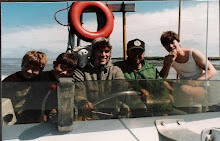





March 22-26, 2009 Vietnam
Xin chao! Hello and welcome to thriving HCMC (Ho Chi Minh City), remembered as Saigon. Waking early, we watched the sun rise as we motored up the Saigon River for two hours into the port area. Boats of all kinds were everywhere! Out in the ocean off Cambodia, we saw tiny basket bowl boats fishing. These coracles are paddled with a figure eight stroke, setting nets, and they are carried out to sea on larger boats. In the river were slim fishing boats dragging a net on two poles behind them, speedboats, junks, hovering ferries, and many scow-like boats with painted red prows and eyes looking forward. There were dozens of huge freighters, and rafts loaded with dirt and sand. Rafts carrying palm fronds looked like moving haystacks! Tugboats, pilot boats, and family boats loaded with watermelons and greens for the market passed by. Several boys jumped off their boat and swam in the river. A dog ran back and forth on the deck, and the father watched as the boys climbed up the anchor rope. We enjoyed watching the river activity and the water hyacinths float up and down with the tide.
The streets were just as interesting. There are four million motorcycles in HCMC, plus cars and buses, bicycles and rickshaw bikes. Helmets are now required by law, and many riders also wear masks. We spent a lot of time in downtown District One of the city, and crossing the streets was an adventure! Look for a slight lull, step deliberately into the street, not pausing, but keeping a steady pace. If you are crossing with others, go in a straight line parallel to the traffic. Look ahead with determination, but be watching traffic at the same time. And, as Wendy says, “Watch your toes!”
The water puppeteers who performed for us actually stand in the pond behind bamboo screens and move the puppets. (I actually had a puppet model at home from Ted & Ginny, so I recognized the characters.) The art originated in the 11th century in rice paddies in northern Vietnam where the art has been perfected.
Thien Hau Pagoda and another Cao Dai temple were colorful. The religion combines all major religions with native Vietnamese spirits, and it is the third largest religion in Vietnam. They believe in one God, the soul, and the use of mediums. In Thien Hau, I lit a spiral incense for Lee’s healing. It will burn for a month.
Ben Thanh and a smaller market were interesting. Lots of vegetables, meats, fruits, clothes, chopstick sets, live fish, coffee, jewelry, and pushy ladies grabbing us to sell blouses and shoes. We also shopped in upscale places, and I had an outfit tailored for me.
I visited Ket Doan Primary School with some university students from the ship. The children were all asking for our autograph, and I realized that I needed to write a sentence for each one so that they could hear me read it and practice speaking. Some of them were shy, and some bravely spoke English to me. During recess, they could go to booths set up in the play courtyard and buy drinks, soup, and toys. They seemed to have money for this. The boys played with a weighted, feathered toy that they kicked like a hacky-sack.
Our favorite day was a trip to the Mekong Delta. We passed rice paddies and fish ponds, but many had been drained and were being developed into modern business buildings and apartments. We traveled on a boat on the Mekong River, and then visited two islands. We rode in canoe boats through the canals, bumping along the narrow waterways in the jungle. We held a python, and Les tried wine with a snake soaking in it.
Now we have two days in the China Sea. We’ll be in Hong Kong on Sunday.












